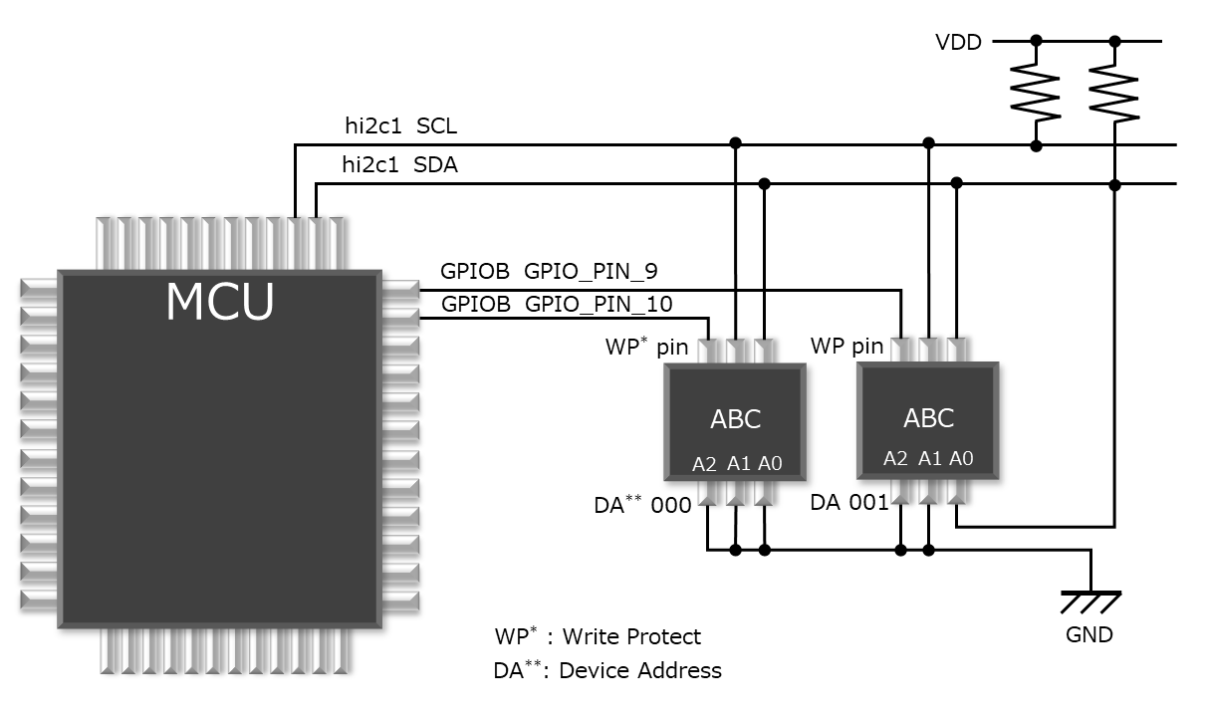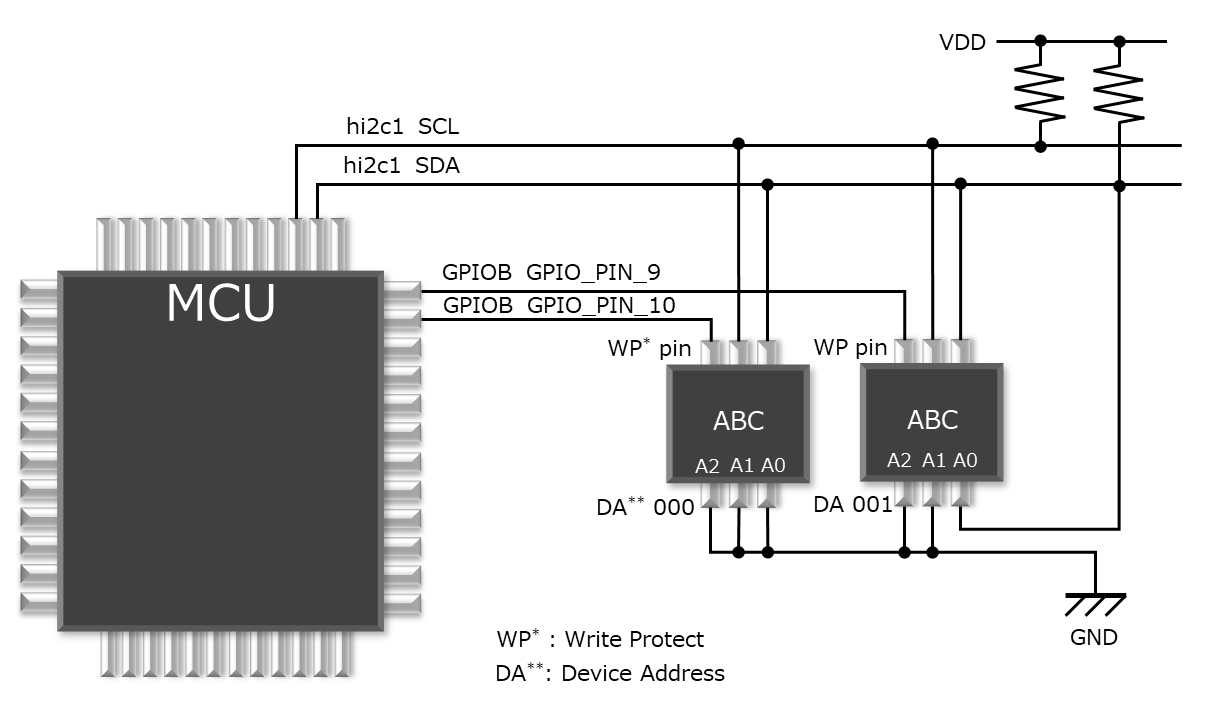Refer to the following example to see how to incorporate several of the same electronic components in a user program.
Exe :
Two electronic components ABC Memory (I2C type), HAL STM32CubeF4

Step1 Add two ABC codes to “oss_ecal.h”
Make the following settings in “oss_ecal.h” (Ver 01.01.00 or later).
1. Added Components number codes eABC_1, eABC_2.
The API function argument etCMP should be used to select electronic components using this code eABC_1, eABC_2, not eABC.
// Components number codes 1 to 49999
typedef enum
{
// ADC components 1 to 19999
eAD22100A = 1U , // Analog devices AD22100A
eAD22100K = 2U , // Analog devices AD22100K
eAD22100S = 3U , // Analog devices AD22100S
eAD22103K = 4U , // Analog devices AD22103K
eBD1020HFV = 5U , // ROHM BD1020HFV
eCHS_MSS = 6U , // TDK CHS-MSS
eCHS = 7U , // TDK CHS-UPS, CHS-UPR, CHS-UGS, CHS-UGR
eGP2Y0A21YK0F = 8U , // SHARP GP2Y0A21YK0F
eGP2Y0A41SK0F = 9U , // SHARP GP2Y0A41SK0F
eGP2Y0A51SK0F = 10U , // SHARP GP2Y0A51SK0F
eLM35 = 11U , // Texas Instruments LM35, LM35A
eLM35C = 12U , // Texas Instruments LM35C, LM35CA
eLM35D = 13U , // Texas Instruments LM35D
eLM45B = 14U , // Texas Instruments LM45B, LM45C
eLM50B = 15U , // Texas Instruments LM50B
eLM50C = 16U , // Texas Instruments LM50C, LM50-Q1
eTMP9A00 = 17U , // Texas Instruments TMP9A00-EP
eMAX6605 = 18U , // Maxim Integrated MAX6605MXK+T, MAX6605MXK-T
eMAX6605V = 19U , // Maxim Integrated MAX6605MXK/V+T
eMAX6607_8 = 20U , // Maxim Integrated MAX6607IXK-T, MAX6608IUK-T
eMAX6613 = 21U , // Maxim Integrated MAX6613MXK+T, MAX6613MXK/V+T
eMPX4250A = 22U , // NXP MPX4250A, MPXA4250A
eMPX5999D = 23U , // NXP MPX5999D
eMPXH6115A = 24U , // NXP MPXH6115A
eMPXHZ6250A = 25U , // NXP MPXHZ6250A
eMPXH6400A = 26U , // NXP MPXH6400A
eMCP9700 = 27U , // Microchip Technology MCP9700, MCP9700A
eMCP9701 = 28U , // Microchip Technology MCP9701, MCP9701A
eTC1046 = 29U , // Microchip Technology TC1046
eTC1047 = 30U , // Microchip Technology TC1047, TC1047A
eS58LM20A = 31U , // ABLIC S-58LM20A
eS5813A = 32U , // ABLIC S-5813A, S-5814A
eS8110C = 33U , // ABLIC S-8110C, S-8120C
eSTLM20DD9F = 34U , // STMicroelectronics STLM20DD9F
eSTLM20W87F = 35U , // STMicroelectronics STLM20W87F
// I2C components 20000 to 39999
eS35710 = 20000U, // ABLIC S35710
eHDC1080 = 20001U, // Texas Instruments HDC1080
eHS300X = 20002U, // Renesas HS3001, HS3003 [01.01.00]
eMB85RC256V = 20003U, // Fujitsu MB85RC256V [01.02.00]
eABC = 20004U, // XYZ ABC [01.03.00]
// SPI components 40000 to 49998
eMAX6675 = 40000U, // Maxim Integrated MAX6675
// User setting number 49900 to 49998 // User setting number Add [01.02.00]
eABC_1 = 49900U, // XYZ ABC Device Address 000 [user modification]
eABC_2 = 49901U, // XYZ ABC Device Address 001 [user modification]
// Non component number
eNON_CMP = 49999U // Non component number
}etCMP;Step2 ABC settings in “user_setting.h”
Make the following settings in “user_setting.h”.
1. Set Device Address ABC_1, ABC_2.
2. Set GPIO CMP_GPIO_NUM, GPIO_ABC_1_WP, PIN_ABC_1_WP, GPIO_ABC_2_WP, PIN_ABC_2_WP for Write Protect.
3. Set I2C CMP_I2C_NUM, I2C_HZ, I2C_ABC, I2C_RETRY.
// Components common setting
//~~~~~~~~~~~~~~~~~~~~~~~~~~~~~~~~~~~~~~~~~~~~~~~~~~~~~~~~~~~~~~~~~~~~~~~~~~~~~~
// Device address Code bit2:A2, bit1:A1, bit0:A0
#define ABC_1 0b00000000 // A2(bit2)=0, A1(bit1)=0, A0(bit0)=0
#define ABC_2 0b00000001 // A2(bit2)=0, A1(bit1)=0, A0(bit0)=1
// I2C components address
#define iABC_DEVICE_CODE 0b00001010 // Device common code
#define I2C_ADR_ABC_1 (( iABC_DEVICE_CODE << 3 ) | ( 0x07 & ABC_1 ))
#define I2C_ADR_ABC_2 (( iABC_DEVICE_CODE << 3 ) | ( 0x07 & ABC_2 ))
// Hardware setting by user
//~~~~~~~~~~~~~~~~~~~~~~~~~~~~~~~~~~~~~~~~~~~~~~~~~~~~~~~~~~~~~~~~~~~~~~~~~~~~~~
// OSS-ECAL GPIO hard wiring
#define CMP_GPIO_NUM 2U // OSS-ECAL GPIO components number
#define GPIO_ABC_1_WP GPIOB // ABC WP : MCU Digital Out Port( GPIOB : Generated by configuration )
#define PIN_ABC_1_WP GPIO_PIN_9 // ABC_1 WP : MCU Digital Out Pin( GPIO_PIN_9 : Generated by configuration )
#define GPIO_ABC_2_WP GPIOB // ABC WP : MCU Digital Out Port( GPIOA : Generated by configuration )
#define PIN_ABC_2_WP GPIO_PIN_10 // ABC_2 WP : MCU Digital Out Pin( GPIO_PIN_10 : Generated by configuration )
// OSS-ECAL ADC components hard wiring
// OSS-ECAL SPI components hard wiring
// OSS-ECAL I2C components hard wiring
#define CMP_I2C_NUM 2U // OSS-ECAL I2C components number
#define I2C_HZ 400000 // MCU I2C frequency
#define I2C_ABC hi2c1 // I2C Handle( hi2c1 : Generated by configuration )
// OSS-ECAL Wake-up components hard wiring
// Communication setting by user
//~~~~~~~~~~~~~~~~~~~~~~~~~~~~~~~~~~~~~~~~~~~~~~~~~~~~~~~~~~~~~~~~~~~~~~~~~~~~~~
// I2C settings
#define I2C_RETRY 3U // Retry timesStep3 ABC settings in “user_setting.c”
Make the following settings in “user_setting.c”.
1. Set ABC_1 and ABC_2 to tblGPIO
2. Set ABC_1 and ABC_2 in tblI2C
const stGPIO_STM32_OBJ tblGPIO[ CMP_GPIO_NUM ] =
{
{ eABC_1 , GPIO_ABC_1_WP , PIN_ABC_1_WP },
{ eABC_2 , GPIO_ABC_2_WP , PIN_ABC_2_WP }
};
// HAL I2C object table for components
const stI2C_STM32_OBJ tblI2C[ CMP_I2C_NUM ] =
{
{ eABC_1 , (I2C_ADR_ABC_1 << 1U) , &I2C_ABC },
{ eABC_2 , (I2C_ADR_ABC_2 << 1U) , &I2C_ABC }
};
